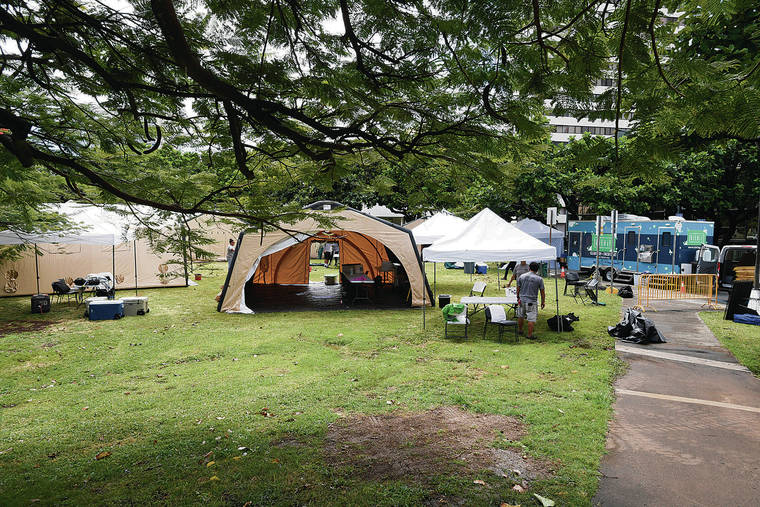TMT on the ropes
It was another setback week for the Thirty Meter Telescope, already delayed three-quarters of a year from its construction start, due to dramatic protests.
The $1.4 billion telescope’s Japanese partner, the National Astronomical Observatory of Japan, confirmed that it was suspending funding for a year “due to the stalemate of the construction in Hawaii.” Coincidentally or not, that came two days after Native Hawaiian protesters gathered at the Japan Consulate-General in Honolulu to deliver a letter asking the Japanese government to join them against the project.
For about five months through last December, protesters camped at Mauna Kea Access Road successfully blocked the start of TMT construction. The state and county spent millions of dollars to have law enforcement on-site but failed to dislodge the protests, which only grew in size, resolve and support. A truce, which promised no construction in exchange for unblocking of the road, ended last Saturday — with little word on what comes next.
Instead came discouraging news of the Japanese backer’s funding suspension, plus reports that TMT’s India and China partners were increasingly looking at the less optimal, but more palatable, backup site of Spain’s Canary Islands. Gov. David Ige and Big Island Mayor Harry Kim can’t simply stand aside and watch that happen. The Mauna Kea road for TMT is getting steeper, and that’s a shame.
HONU’s homeless helped
Many in the Moiliili area are frustrated about growing homelessness in parks and sidewalks, but some new tents at Old Stadium Park might be worth the pop-up.
The Homeless Outreach and Navigation for Unsheltered Persons (HONU) project, which launched Monday at the park at South King and Isenberg streets, is tackling the problem where it lives. The concept is promising: Temporary inflatable tents provide cots and shelter, while smaller stations provide social-service staff who work with homeless persons to transition into more-permanent shelter and other help.
Taking the triage-like operation — including a hygiene center with toilet and shower, plus food and laundry — near existing homeless enclaves makes sense. Over the next 90 days, it’s hoped that such proximity to outreach will get many the help they need to get off the streets.
The other, necessary component of this carrot-and-stick approach is that police will be intensifying their presence within a few-miles radius of the HONU site, to enforce laws regarding use of public spaces. While rousting encampments often just means they regroup in other public spots, this combination of enforcement and one-stop help hub has merit.
And importantly, it’s seen some early success. HONU comes to Old Stadium Park after a test run at the Waipahu Cultural Garden Park. From December through Monday, when HONU left that site, 258 homeless people were helped there, including 156 who moved into shelters and one who went into permanent housing. Another 90 “self-exited” to stay with family, enter a medical facility or move on.
The city is looking at similar numbers to be reached, about 250, at Old Stadium Park. Hope for success, so that HONU can pop up at its next spot at the end of April with anticipation.
Get ready to vote by mail
Get ready, Hawaii: This fall, elections statewide will be done primarily via mail. That brings a host of challenges: some unaware voters will surely show up at nonexistent polling precincts on Primary Election day, Aug. 8; plus, expect confusion over when ballots are due and must be received by the Office of Elections.
Add this to the list: Voters casting so early that they miss evolving situations just before Election Day. This wrinkle was seen on the national level on Super Tuesday, when Democratic presidential candidates Joe Biden and Bernie Sanders battled in more than a dozen mainland elections. As columnist Jonah Goldberg noted, as many as 40% of California voters voted early — up to a month before Tuesday, and some even before Amy Klobuchar, Pete Buttigieg and Tom Steyer withdrew. Those Californians’ early votes that went to any of that trio simply didn’t count.
Mail-in voting is convenient, to be sure — but its prolonged voting window can be problematic. Candidates already know this, in trying to tailor messaging and ad buys timed for early voting through election day.
As for Hawaii voters registered for the Aug. 8 primary: Expect to receive a mail-ballot packet about 18 days before election day. Vote and mail from the comfort of home. Or, starting July 27, voter service centers will be set up in each county to either drop off the ballot or vote in person. Locations and hours of these voter centers will be announced in May, so stay tuned.
It will be incumbent on the state Office of Elections to provide as much info as possible, early and often. Voters, too, have responsibility to stay educated: see elections.hawaii.gov/voters/hawaii-votes-by-mail/ Opens in a new tab.

